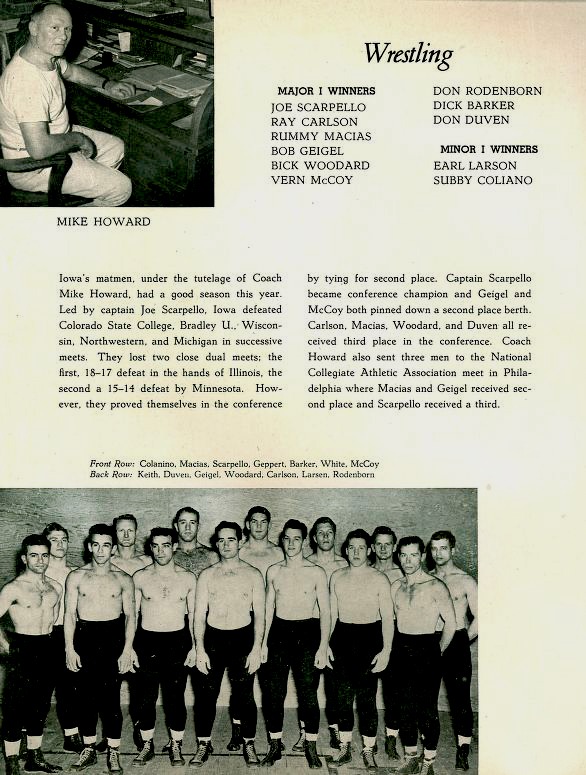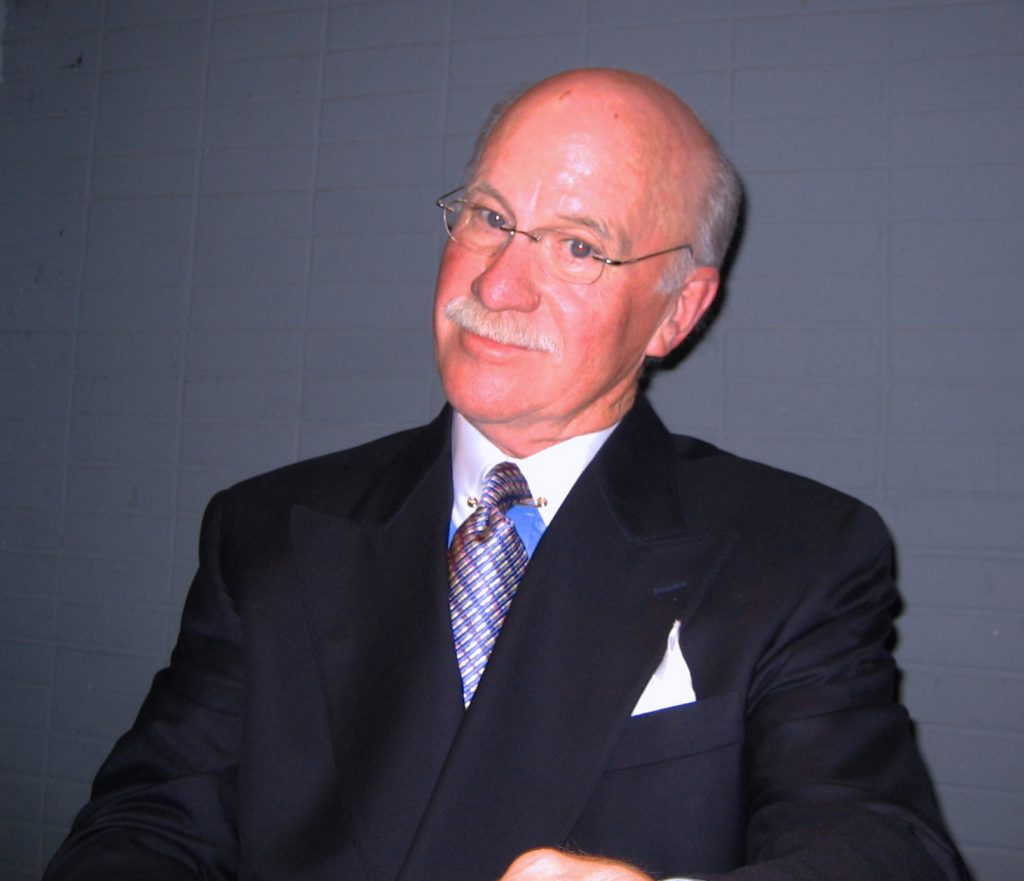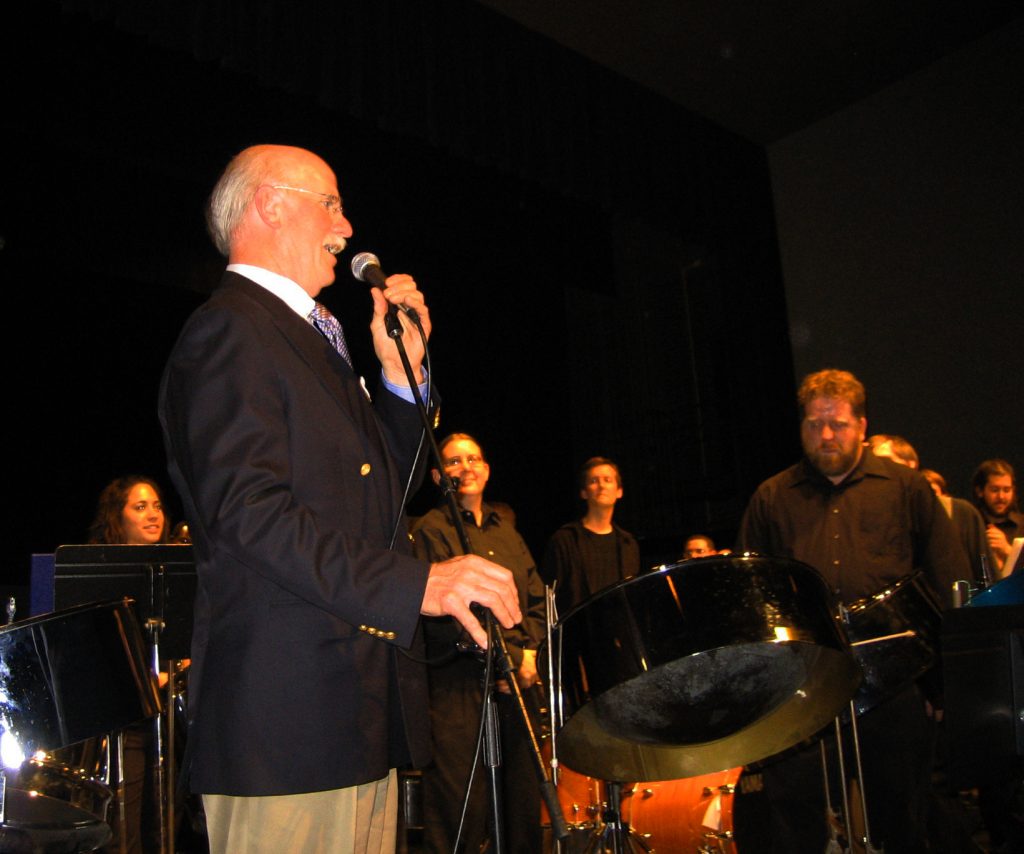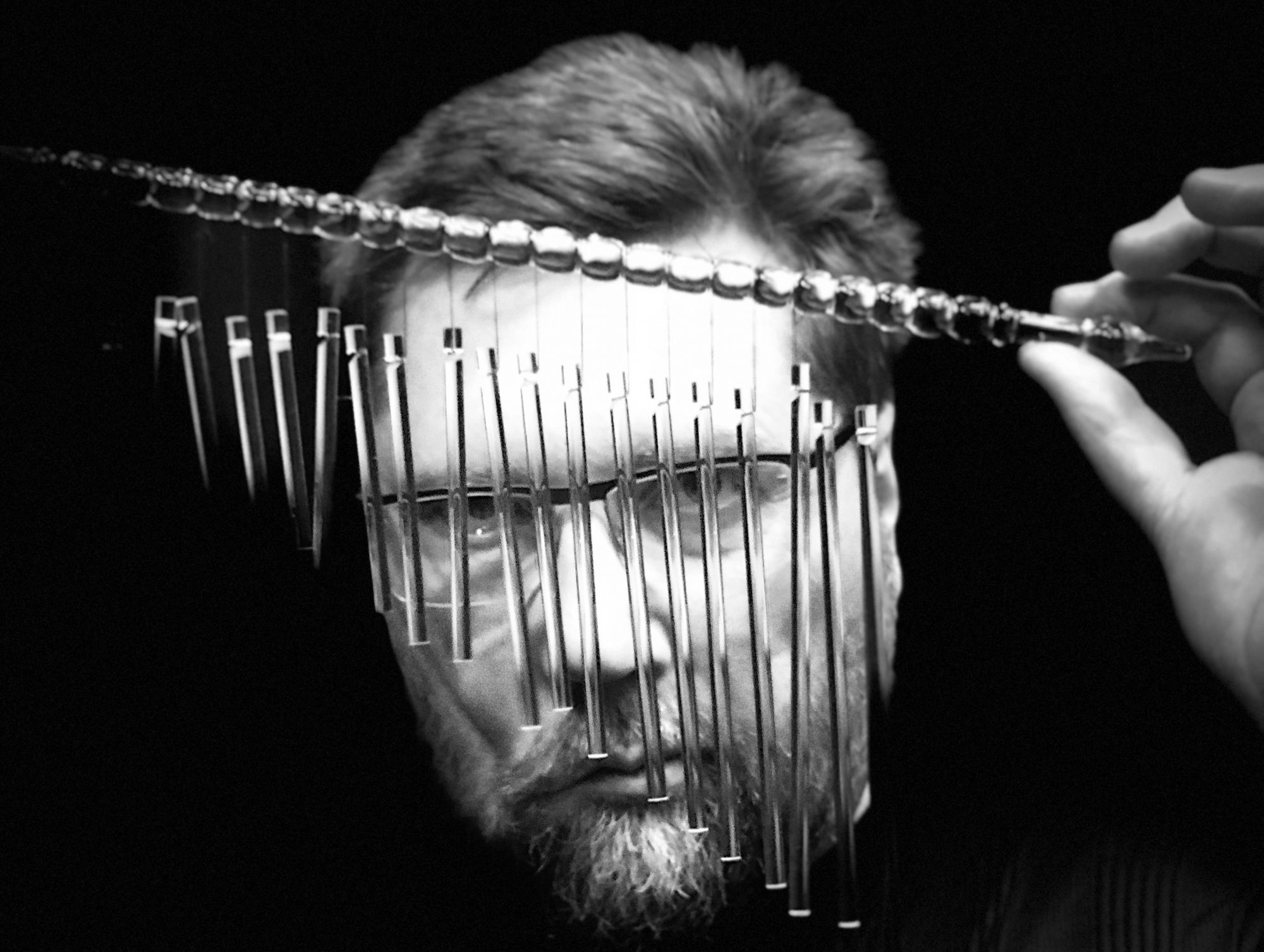In 1983, as one door closed to me, another opened in a most unlikely place, Wichita, Kansas. I won’t tell you how long it took me to be able to effortlessly spell “Wichita,” but it was there that I came under the tutelage of Dr. J.C. Combs—one of the blessings of my life.
At the time I entered Wichita State University as a graduate student, Dr. Combs was enjoying a successful academic and performing career. But like a lucky few of his kind, J.C. was conflicted. He had one foot in the classical world and the other in the avant-garde. If he had more than two feet, they’d have been dipped equally into jazz, vaudeville, country, Elvis, and Bootsy Collins.
As a college percussion professor and a certified cut-up, J.C. despised playing percussion ensemble concerts to mostly empty houses. He thought that much of the contemporary repertoire for percussion was of little interest to the average concertgoer, so he began to create over-the-top percussion events to attract larger audiences. He used theatrical lighting, staging, video projections, actors, dancers, singers, poets, smoke and mirrors, you name it. His collaborations resulted in compositions for percussionists performing with pinball machines, bowlers, cloggers, jugglers, Gospel choirs, a “Velcro” tap dancer (a story for another day), and wrestlers (well, maybe not the kind you would find in Iowa).
“I haven’t seen Iowa people get so excited since the night Frank Gotch and Strangular Lewis lay on the mat for three and a half hours without moving a muscle!”
Mayor Shinn, from The Music Man
Yes, wrestlers. The Wichita Symphony (for which J.C. served as principal timpanist) rehearsed at the Century II Performing Arts and Convention Center in one corner of the building, and in the other corner (so to speak) were professional wrestling matches. There, in the backstage area, he met some of the wrestlers and began hatching a plan for his next big event. They suggested he get in contact with National Wrestling Alliance (NWA) promotor and referee Bob Geigel in Kansas City. J.C. floated his idea about a collaboration to Geigel (a former University of Iowa wrestler and football player) and the project took off from there.

Somehow J.C. persuaded his colleague, Dr. Walter Mays, to compose a work for large percussion ensemble and wrestlers. Combs and Mays had already collaborated successfully on Six Invocations to the Svara Mandala, for which Mays won the Percussive Arts Society Composition Contest (1974), and a Naumburg Recording Award (1975). He had just been nominated for a Pulitzer for his oratorio Voices of the Fiery Wind, but his next major (and most infamous) work was War Games for Extended Percussion and Professional Wrestlers.
In addition to a large battery of standard percussion instruments, the work called for jack hammers, piano played with carpet-covered 2X4s, two drum sets without cymbals, a regulation fight ring, two wrestlers, and a referee. The now legendary work was presented at the 1983 Percussive Arts Society International Convention in Knoxville, Tennessee, and I was a performer on that memorable concert. Even in the huge ballroom, the audience was standing room only, and from my position in the ensemble I could see influential percussion teacher and PAS Hall of Fame member Haskell W. Harr, at age 89, standing up from his wheelchair to be able to watch the entire performance. The crowd went wild. It was the talk of PASIC that year, and of many years to come. The 30th Anniversary of PASIC Commemorative Program Book includes a photo of our performance.

That performance garnered both praise and criticism (cheers and boos in wrestling parlance) but it also secured J.C.’s reputation as “a cross between John Cage and P.T. Barnum,” a characterization made by Dave Samuels.
One assessment of which J.C. is particularly proud came as the result of a chance encounter with a musician who was well known for his musical opinions. J.C. tells the story of a visit he made to New York City’s Hell’s Kitchen around the time of the production of War Games. While strolling around the city, he happened to hear the familiar sounds of a percussion ensemble wafting from an upstairs rehearsal hall. Never a shrinking violet, J.C. talked his way inside to see what was happening, and found himself in the company of Frank Zappa.
When the mercurial Zappa learned that J.C. was a university percussion teacher, he asked what sort of things he did with the ensemble. Expecting to hear of music by John Cage, Lou Harrison, or—Zappa’s idol—Edgard Varèse, he was surprised when J.C. described the wrestler piece in full detail. When he finished, Zappa said, “That’s the outest [stuff] I’ve ever heard of.” J.C. knew that if Frank Zappa thought he was “out,” then he must be doing something right.
“That’s the outest [stuff] I’ve ever heard of.”
Frank Zappa
In a recent phone conversation with J.C., I told him what a profound experience it was to be with him at WSU during that memorable time: with all the cool, one-of-a-kind projects we did, and how his positive and creative energy led us to so many amazing and memorable experiences.
But he turned it around on me. To J.C., it was the energy he felt from his students that motivated him. When he got an idea, he was emboldened to pursue it because his students always “took the ball and ran with it.” They not only embraced his (often outrageous) schemes, they added their own ideas along the way. They became part of the creative process. It was this positive energy loop that was responsible for many of the creative projects accomplished by J.C. and his students.
He said, “I was just plugging into my student’s creativity; the excitement of kids running the show.” That’s when I reminded him of the time one of those “kids” drove a golf cart onto the stage as part of a bit before the ragtime marimba band played. They tested the cart and the stopping distance on the stage (without passengers) but with the full complement of the marimba band on board, the stop was a little too close for comfort for audience members in the first few rows. He laughed and said, “Creative things aren’t always without risk.” He recalled that others were concerned about his productions as well. “I once had a dean ask me if I knew what I was doing? I just said ‘yes’, he said ‘OK,’ and that was it.”

Creative projects require tremendous physical and mental energy, but possessing that energy doesn’t necessarily promise success if the possessor remains inactive. There must also be a catalyst to set things in motion. J.C. was the catalyst that jump-started our energy. When participants get excited and on board with the creative process, it tends to self-perpetuate. By definition, this is synergy.
Synergy, a buzzword frequently dismissed today as business jargon, is the sharing of creative ideas that amplifies energy in unpredictable ways. The old saying that the “whole is greater than the sum of its parts” is a classic illustration of the word synergy.
So, it wasn’t energy alone that was the driving force behind most of J.C.’s wild ideas, it was the synergy created when everyone became part of the process and felt empowered to contribute. There are many teachers and creatives who have a lot of energy, or who push their students to do great things, but do they generate, and perpetuate, synergy? Are they a catalyst?

Dr. Combs told me that when he would visit other schools as a clinician, he often found an energetic teacher full of creative ideas, but he didn’t always sense the same enthusiasm from the students. “Everything was flowing one-way: from the teacher to the students. There was just dead energy, and I thought, why don’t teachers just get out of the way of their student’s creativity?” A catalyst can quickly become an inhibitor if energy can’t be turned into synergy.
Without synergy, students may only go as fast or as far as they are pushed (or dragged in some cases) and when that external pressure is removed, inertia sets in and nothing else happens. Some teachers believe it isn’t their responsibility to get students to “buy in,” but creating something worth buying in to is an important first step toward developing a perpetual culture of creativity.
One energetic person acting alone can certainly bring a project to a successful conclusion, but it is difficult to sustain that energy if you have to pull the creativity wagon alone. It is much easier—and way more fun—to engage the creativity of others.
I consider myself lucky to have experienced energy and synergy both as a student and as a teacher. Thanks Dr. Combs!


” Creative things aren’t always without risk”. I love it! Very much enjoyed reading this article!!!
I remember when I first moved to Wichita and told people I was a grad student at the music school their first question was do you know J.C. Combs? He was a legend. People flocked to his concerts just to see what he has cooked up this time. My time there was the best because he let me follow creative ideas and was patient with my brand of composing for ensembles and myself. Thanks for this nice tribute to him.
I recall that Edward Woodward (who plays wild and wacky whythms on wood blocks) was one of the main spokes in the creative wheel that rolled through Wichita in the early 80s. One of my favorites of your creations was MTV (Mallets, Toms, and Vibes) and who could forget March Funky, that you wrote for me. I also played Bee Keeper with the Iowa Percussion Ensemble a couple of years ago. Good times my friend.
MTV REUNION!!!
Dan, I was one of the fortunate members to premiere the original performance of “War Games” at WSU. I remember the entire process of Walter Mays bringing in a few sheets at a time and changes being made at each rehearsal. As you mention we all had bought into the piece so much that we would have done anything to make it happen. The whole thing got real on the afternoon of the performance as the wrestling ring was assembled on the stage in Duerkson fine arts center. Many of us were on hand to watch the crew work. On the night of the performance the crowd was standing room only. One of my favorite memories is a part where a bass bow was being drawn across styrofoam. It happened to be at the same time as the wrestlers were engaged in a headlock, sounding as if their neck was being twisted off. Shortly before the end of the piece Bob Geigel, who was the referee for the match got thrown from the ring bringing the crowd to its feet. The two drum sets took the energy from the wrestlers as the action accelerated. As Bob Geigel climbed back into the ring the wrestlers finished with a flurry of moves pinning one of the wrestlers to the mat as the music finished with is final flurry as the champions arm was raised. The crowd went nuts!
We had a lot of great performances but this and the “Pinball Metamorphosis” were some of the most memorable.
Dennis, this adds excellent perspective on exactly the type of synergy that J.C. created. You couldn’t help but get caught up in it. I wonder if you have a program of the premiere? What was the date of the first performance?
Dennis, the part about Bob Geigel getting tossed out of the ring is amazing considering that he was probably close to 60 years old when War Games was produced. Wow!
Beautiful words describing an incredible spirit and force for good in our world. Thank you, Dan!
Love,
M@
Thank you , Dan.
You captured him exactly right!
Karen Combs
Hey Dan,
Great job here!
Am not a musician at all but am proud to be part of the Combs Family and what a brilliant tribute to a brilliant teacher and person. Huzzah!
Raj Goyle
Thank you for this beautiful tribute, Dan. Both Dr. Combs and Dr. Mays completely reframed my view of music and creative possibilities! Knoxville was an amazing trip. I remember sweating out the War Games performance as the wrestlers showed up at very, VERY, last minute. I also remember your innovative drum line creations were a blast.
Thank you, Dan, for putting words to how all of us feel about JC. His entire teaching career was a masterclass in how to create a wide-open artistic environment that was fed and nourished largely from within. His entire style and approach with his students and colleagues was a lasting example of how not to just get the job done, but get the job MORE than done. To go further and explore, yet still keep a foot in old soil. My biggest takeaway from my many years with him as my teacher has to do with the nuances of how to direct one’s energy to things that have a chance to really blossom. He’d get an idea, assess what needed to happen to make it a reality, and get to working making it all happen. (which usually meant a few hundred phone calls and maybe a few golf games with bankers!). It is good to read your essay, Dan, and the comments that followed.
I got to know J.C. first through clinics he gave at UNM when I first started teaching there in 1980. He was an inspiration to me as a young percussionist and faculty member. Such incredible energy! He told me about all the inventive things he was doing at Wichita, including the wrestling piece, but nothing prepared me for the PASIC concert in Knoxville. That War Games performance was unforgettable! I’ve been thinking lately about J.C. and what a influence he was on me. So thanks for writing this Dan and if you are in contact please give J.C. my best!
He is an amazing mind.
I wish him and I would have meet under different circumstances. It just didn’t happen that way. 2002 was an extremely rough year for both of us.
I still respect the dude fully.